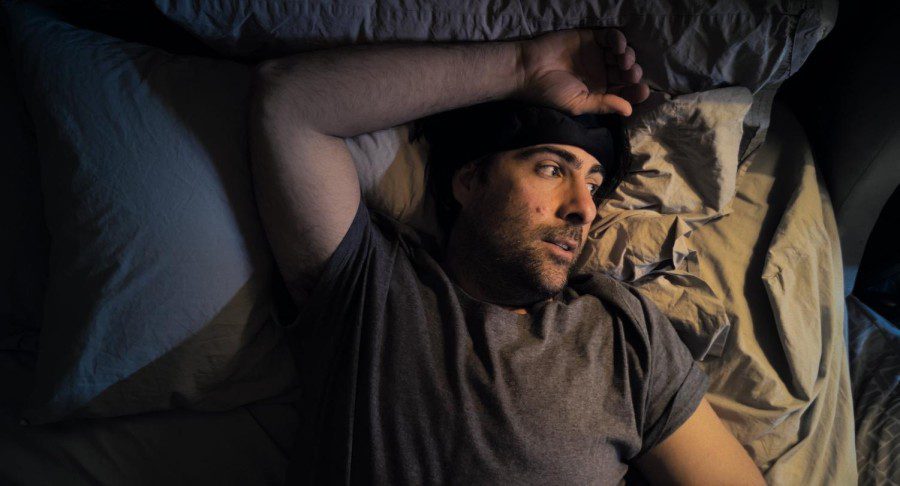Review: ‘There There’ shoots for real emotions, despite its fake portrayal of them
American auteur Andrew Bujalski’s latest tests its viewers’ faiths by pairing scenes from actors who were never in the same room. “There There” opens in select New York City theaters on Nov. 18.
Jason Schwartzman appears in “There There,” a recent film release by Magnolia Pictures. (Courtesy of Magnolia Pictures, Photo by Matthias Grunksy)
November 15, 2022
A memory returns to me of my mother frustrated and crying after a Sunday trip to the movies. Such melodrama is to be expected of my family, but here, the source was of extreme interest, for I had chosen the movie. It was some Hollywood-Holocaust commodity, the likes of which I had selected for our evening ritual because I had anticipated it being an Oscar picture. My teenage brain found it easier to follow prescribed meaning rather than seek my own when it came to choosing what was of the utmost importance to check out at the nearby, now-deceased ArcLight Cinema in La Jolla, California.
My mother said something along the lines of, “We go to the movies to smile, not to depress ourselves, there’s enough of that already.” And so, karma — as we Westerners have come to reduce it — would have it that, however many years later, I would be tortured by Andrew Bujalski’s “There There.”
A strange and strangling little film, “There There” draws on absurd, everyday situations through the lens of aimless — perhaps doomed — characters. I, assuming the role of total amateur critic, would sit through a festival product that could be best described as sad schlock and find it vacuous, for its visions of mundane melancholy made me yearn for something to smile about, not something to smirk in response to.
Taking six months to make, this film is Bujalski’s longest production. Made during the height of the pandemic, the filming of “There There” followed a crazy, and rather brilliant, logic that upheld safety as the highest level of authority. Actors would never be in the same room, and its editing would reproduce continuity through sleight of hand.
What you end up with is an anthology film featuring extended scenes depicting troubled people who talk and — thematically or narratively — pass the baton to another duo of discomposed conversationalists. The series opens with a sincere conversation about middle-aged hookups, featuring a show of candidness from Lennie James and Lili Taylor and crescendos toward absurdity. An argument between anxious husband Jason Schwartzman and the ghost of his grandfather is the highlight. Despite the barrenness of each set and the ranging wildness of each moment, every scene is embraced as wholly real by the camera — accentuating the funny way by which our thoughts encroaching on what we see produces more meaning than simply looking at something does.
Considering the isolated conditions under which the film was made, a commentary on communication manifests itself, hilariously poking fun at the way we often speak to ourselves when we attempt to talk to others meaningfully. Not just “There There,” but Bujalski’s filmography as a whole seems to question why we yearn to be understood in common expression? Whether it’s the protagonist aspiring to look good by adopting a fitness routine in “Results,” or the nerds interested in sharing their programming skills with each other in “Computer Chess,” Bujalski appears adamant about exploring the fallacies inherent to miscommunication.
Bujalski’s films are typically riddled with these gaps, with silences and mumbles, the latter being talk akin to silence by virtue of its indiscernibility. He is a director who has crafted a career around nothing. And for the most part, masterfully. He is the American poet par excellence of the nothing film where pointless conversations are key, ignorance in aesthetics reigns, and, well, nothing happens. To circle back, the type of movie my mom — representing the average moviegoer — detests.
Yet, he has been widely described as “godfather of mumblecore” because the simplicity of his films was so unique that critics were sure they’d inspire a new movement in American cinema, an unfounded hope that became a historical misnomer subject to all sorts of criticism within art circles. However, though American directors have since challenged his title with their own abuses of the medium by filling it up with meaningless time (see Joel Potrykus and Tyler Toarmina), Bujalski remains the guy you think of when it comes to filmmakers rendering the painfully quotidian with a pang of poignancy that makes it noteworthy.
If Bujalski is the king of nothing movies, why was I so bothered this time? His films had certainly made me uncomfortable before. They’d bored me, but they’d also left me with the type of smile that follows fruitful thinking, maybe a revelation. There was none of that this time around: just boredom and frustration. I, much like my mother, thought to myself, “We go to the movies to experience something, not waste our time.”
“There There” was indeed riddled with musings on life, its magic and its melancholy. It deals with communication in a way few films do these days, but it was its staging — so full of artifice — that made me utterly disinterested. Although each character’s lines were wisely written, the mark of inauthenticity that accompanied their delivery reduced their meaning. Thus, the whole picture bore the mark of insincere theatricality.
The beauty of Bujalski’s previous films was that their simplicity perfectly captured something that felt real. Instead, this film’s manufactured realness made me feel cheated. It was rife with falsity, and I could not take any of it seriously as a result. The crafty appeal to continuity, the unprofessional look of iPhone footage, and the unchecked acting that presents itself more like melodramatic monologuing than a real conversation marred my ability to immerse myself in the themes of “There There.”
Its realness, which it equated with disillusioned subjects because we’ve come to equate drama with high art, meant nothing. I am not able to sink into the film, “depress myself,” in the words of my mother, nor can I think back on the experience with a smile. Perhaps “There There” represents a career apogee for Bujalski; not only is it a film about nothing, but it is nothing as a film. Because its reflections on life are so contrived by their staging, they become totally distant; they bestow an exercise in forlornness rather than immersion for the viewer.
My mother wanted escapism at the time, and in a way, I sought the same under the pretense of immersion. Although I wasn’t entirely looking for something that would make me smile and thus could afford something that made me sad, I was always on the lookout for something that would curl me up in its image and make me forget about the world beyond the screen. “There There” does the opposite, pushing the viewer away by testing their faith in the images at hand, images sapped in the fakery of spaces that are obviously sets populated by overacting. Rather than promoting thought, it forces it. The result is an uncomfortable viewing experience that can be thought of cheekily, but not contemplatively.
Contact Nicolas Pedrero-Setzer at [email protected].

























































































































































